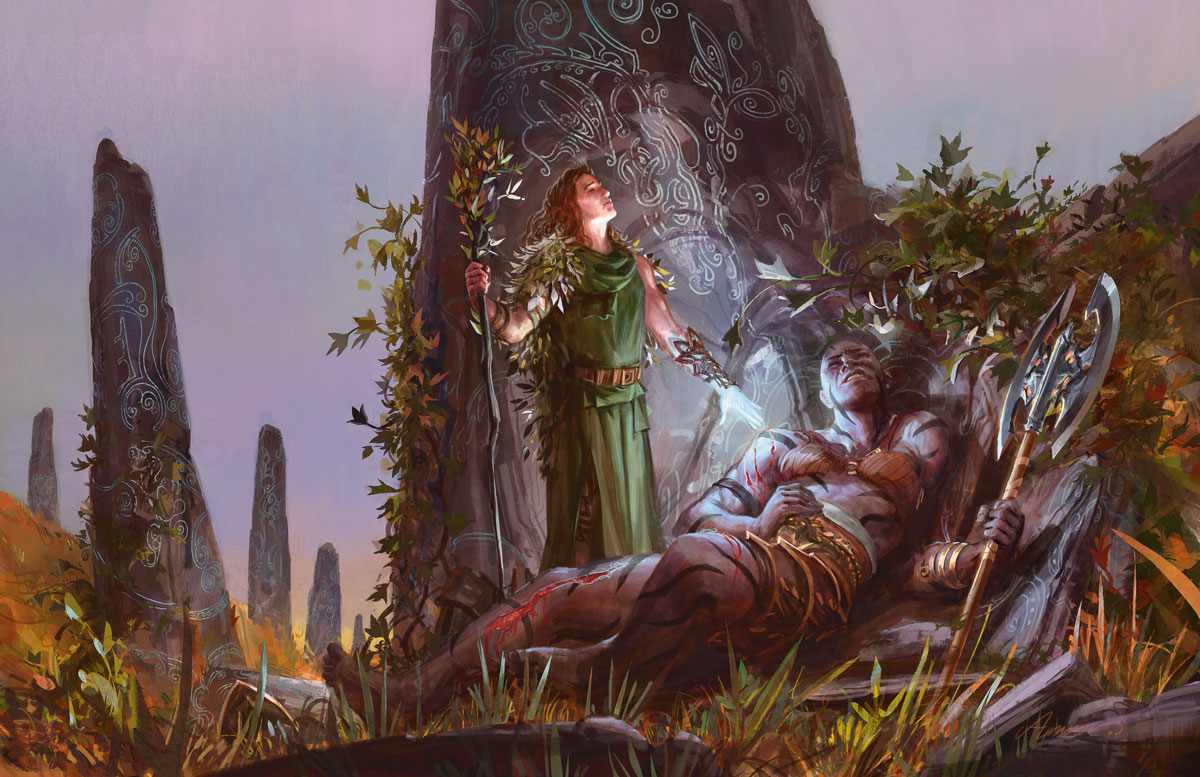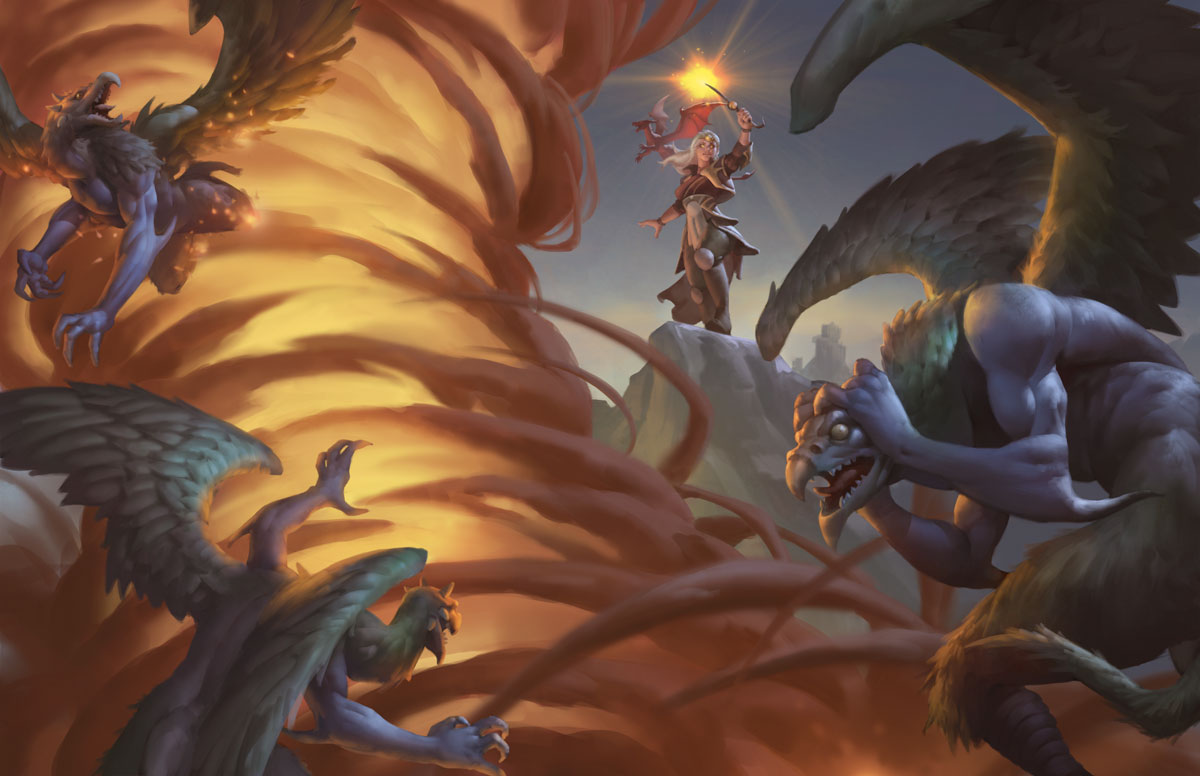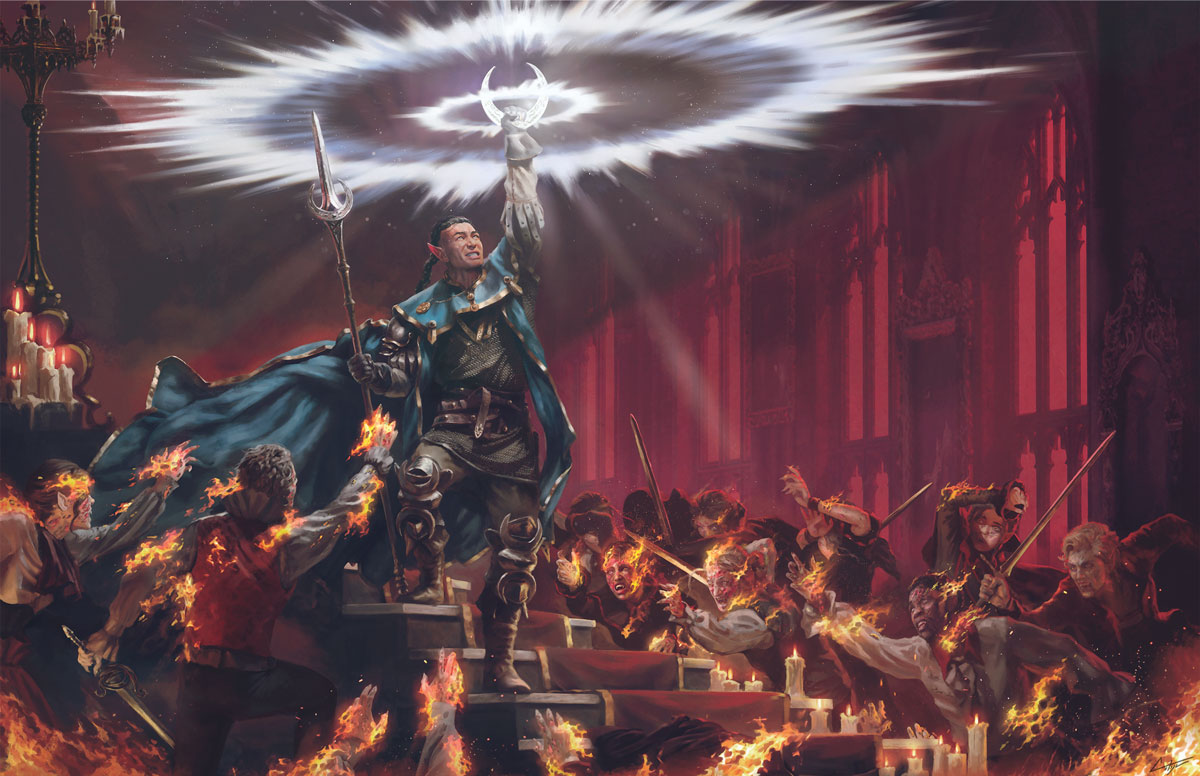Magic is one of the main elements that make Dungeons & Dragons so cool. Whether you’re pulling the Weave, strumming along to the Words of Creation, or drawing forth the divine power of your chosen deity (or patron!), using spells can give you the ultimate power fantasy: The ability to literally reshape the world around you. That’s why the 2024 Player’s Handbook is bringing you over a hundred pages of spells. You’ll find boosts to classic favorites, popular spells from sourcebooks being ported to the core rules, and even some brand-new spells!
In this article, we’ll discuss some of the overarching changes you’ll see with spells and even show you some of the new spells introduced in the 2024 Player’s Handbook.
- Many Favorite Spells Have Been Boosted
- It’s Easier to Find and Use Your Favorite Spells
- New Spells for the Core Rules
- Emanation Area of Effect
The 2024 Player’s Handbook is Now Available!
Buy the 2024 Player’s Handbook today and dive into revised rules, enhanced character options, and exciting gameplay innovations.
Get your copy on the D&D Beyond marketplace and seamlessly integrate your new content with D&D Beyond's library of digital tools built to make D&D easier, so you can focus on the fun!
Many Favorite Spells Have Been Boosted

One of the first things that long-term D&D players will notice when perusing the almost four hundred spells in the 2024 Player’s Handbook is that many of your favorite spells have been buffed up.
Your healing spells will keep you and your allies on your feet longer to reflect the cost of your action or Bonus Action and your spell slot in order to use them. For example, Cure Wounds now heals a base of 2d8 + your spellcasting modifier, and Healing Word similarly has a base of 2d4 + your modifier as a level 1 spell. And it’s not just dice increases. Many spells receive a new element of functionality. Prayer of Healing, which takes 10 minutes to cast, now grants the benefits of a Short Rest to up to five creatures in addition to restoring 2d8 Hit Points.
Damage-dealing spells have seen several boosts too. Cloud of Daggers used to have some diminishing returns on later rounds if enemies started to avoid your cube of swirling stabs. But that’s a thing of the past, because now you can use a Magic action on your later turns to move the cloud up to 30 feet. Similarly, Chromatic Orb has been updated with the potential to strike an additional enemy, really embracing the dodgeball vibe or chucking a magically infused sphere at your enemies.
A number of spells that saw little use from the 2014 Player’s Handbook version also saw some tweaks to make them more functional and enticing for you to add to your repertoire. Blade Ward, for example, was a fairly underused cantrip because it cost an action, only lasted a turn, and only granted resistance to Bludgeoning, Piercing, and Slashing damage for that one turn. Now, while it still takes a Magic action, this cantrip lasts for a full minute, with Concentration, and forces all enemies attacking you to subtract 1d4 from their attack roll for the duration.
These are just a few of the changes to some known spells, so be sure to look for your favorite spells in the 2024 Player’s Handbook to see what changes may be in store for you!
It’s Easier to Find and Use Your Favorite Spells

Speaking of looking up your favorite spells, the 2024 Player’s Handbook makes the process of finding, preparing, and using your spells as a player easier.
Now, you no longer need to flip to the back of the book to see what spells are available for your class. Each class has its designated spells listed in the class description for the class itself in the Character Classes chapter. So if you’re building a Cleric, the list of Cleric spells is right there in the same section as your class features and domain subclasses.
One of the big missions in revisiting spells was to really listen to and address questions and confusions players have had around various spells in the decade since the 2014 Player’s Handbook was first published. We tightened up the wording in some spell descriptions to make them clearer and more succinct, without changing the actual mechanics of the spells. We provided more artwork of the spells in use to give you more inspiration for imagining how the spell looks when you cast it. The Ritual tag has now been moved to the casting time to make it easier to find since it impacts the casting time of a spell.
As an example of changes to spells, the conjuring family of spells, such as Conjure Fey and Conjure Celestial, have been updated to officially reflect popular modifications that were playtested in Unearthed Arcana. The new versions of the spells now give you all the information you need when casting them in the spell descriptions themselves; for example, Conjure Fey specifies that the conjured spirit can make a melee spell attack against a creature within 5 feet, and on a hit, the target takes Psychic damage and has the Frightened condition.
This saves you from cracking open the Monster Manual to track your conjured creature’s information and makes them operate more similar to the Spirit Guardians or Spiritual Weapon spells.
New Spells for the Core Rules

The 2024 Player’s Handbook introduces some brand-new spells to the D&D spellbook. Some, like the Starry Wisp cantrip, were included in the Unearthed Arcana playtests, but some weren’t and will be making their debuts in the 2024 spell list.
Some of the brand-new spells include ties to the known spellcasters within the D&D multiverse. Our old pal Tasha has a brand new spell, Tasha’s Bubbling Cauldron, which creates a magical cauldron for 10 minutes that you and your allies can reach into and grab vials of a Common or an Uncommon potion of your choice. Jallarzi, a Celestial Patron Warlock with the distinction of being a non-Wizard member of the Circle of Eight, has a powerful namesake spell, Jallarzi’s Storm of Radiance. This spell creates a raging 40-foot cylinder storm that deals Radiant and Thunder damage. It also gives creatures within it the Blinded and Deafened condition and makes them unable to cast spells with a Verbal component.
Popular spells from the expanded sourcebooks have also now become part of the core spell list. Some, like Toll the Dead, introduced in Xanathar’s Guide to Everything, have gotten so ubiquitous that many don’t realize they weren’t initially part of the 2014 Player’s Handbook.
Emanation Area of Effect

Emanation is a new area of effect, joining known types like Cone, Line, or Sphere. An Emanation spell extends in a straight line in all directions from a creature or object, and moves with them if the spell duration is longer than Instantaneous. Emanation differs from a Sphere in that its origin is not considered part of the area of effect unless the Emanation’s creator decides otherwise (whereas a Sphere’s origin is always included in the area of effect). Known spells such as Thunderclap and Spirit Guardians are now classified as Emanation for their areas of effect.
This Spells Fun
The 2024 Player’s Handbook is now available on the D&D Beyond marketplace, which means it's time to set out on new adventures with fresh or familiar characters!
With almost four hundred spells spread across over a hundred pages, we’ve clearly only scratched the surface of the exciting changes coming to your spellcasting with the 2024 Player’s Handbook. Be sure to look through the complete spell list for your preferred spellcaster to see what changes are in store for your favorite spells, and what new spells are ready for you to play with.
We’re delighted to share with you the changes to fifth edition D&D that appear in the 2024 Player’s Handbook. Make sure to keep an eye out on D&D Beyond for more useful guides on using the wealth of new options, rules, and mechanics found in the 2024 Player's Handbook!

Riley Silverman (@rileyjsilverman) is a contributing writer to D&D Beyond, Nerdist, and SYFY Wire. She DMs the Theros-set Dice Ex Machina for the Saving Throw Show, and has been a player on the Wizards of the Coast-sponsored The Broken Pact. Riley also played as Braga in the official tabletop adaptation of the Rat Queens comic for HyperRPG, and currently plays as The Doctor on the Doctor Who RPG podcast The Game of Rassilon. She currently lives in Los Angeles.
This article was updated on August 13, 2024, to issue corrections or expand coverage for the following features:
- It’s Easier to Find and Use Your Favorite Spells: Added Conjure Fey as an example of how the new spell listing works.
- New Spells for the Core Rules: Remove plurality in the Tasha’s Bubbling Cauldron sentence to avoid confusion.
- Emanation Area of Effect: Clarified that the Emanantion’s creator can choose to include the origin in the area of effect.








-
View User Profile
-
Send Message
Posted Jul 7, 2024im mortified by the pun. but this looks fancy, so im not complaining. also, no mention of fireball? srsly? ITS A STAPLE OF DND JOKES CMON WIZARDS
-
View User Profile
-
Send Message
Posted Jul 7, 2024There is too much healing in D&D 2024, the doubling of healing effects, the new class options for healing, and Potions as a Bonus action are going to cause so much bloat in players health pools, that DMs will struggle to have monsters keep up with the inflated numbers. You've ruined your own back end math to the game and will only cause combat to slow down and be irrelivant in the long run.
That along with the return to BAs being critical to the players turn like Minor Actions once where, it's like you learned nothing from the failure of 4e.
-
View User Profile
-
Send Message
Posted Jul 7, 2024I honestly would have purchased the 2024 PHP update if it were JUST the same book and classes and spells but in the new format. Having the spells listed right in the class section is a game changer on it's own. This makes me so excited for the new DMG.
-
View User Profile
-
Send Message
Posted Jul 7, 2024Whats the point of catnap then..?
-
View User Profile
-
Send Message
Posted Jul 7, 2024Are they gonna come out with another 2024 class article?
-
View User Profile
-
Send Message
Posted Jul 7, 2024After they finish the next class video this upcoming week they should be releasing more class articles
-
View User Profile
-
Send Message
Posted Jul 8, 2024How is having AC of 22 on a spellcaster not broken?
-
View User Profile
-
Send Message
Posted Jul 8, 2024Magic Action is like the Attack Action for spellcasters. Most of the time it's casting a spell, but some features and magic items also use it.
A big part of why it's being added, other than consistency with other action types, is to let Fighter's Action Surge exclude the Magic Action, so you can't cast two spells one after another.
-
View User Profile
-
Send Message
Posted Jul 8, 2024It only lasts for the round. It costs a reaction and spell slot. It only adds 5 to the AC, so for a spellcaster to get AC 22 using Shield then they already have AC 17! That is hardly broken.
-
View User Profile
-
Send Message
Posted Jul 8, 2024Oh come on, these sorts of things are commonly done as homebrew anyway. Now it is just more official. If you don't like it then don't allow it!
-
View User Profile
-
Send Message
Posted Jul 8, 2024This.
Over the last weeks I've seen all the Class changes and buffs stack up and stack up and given what I'm looking at, I have no clue how I'm supposed to make combat challenging but fair. Challenging sure, but at that point I'd have to tailor every encounter to exploit what few weaknesses the classes have left.
I get why WotC is focussing on the Classes first but looking at what they are turning into, this doesn't seem fun to DM.
-
View User Profile
-
Send Message
Posted Jul 8, 2024Similar reactions only boost AC vs the triggering attack and offer less AC. Throw in moderately armored feat which you get for free at lvl 1 in the 2024 version and you have a caster with a base AC of 19 without magic items and 24 with shield. martial characters can reach 21 AC max without magic items. If we throw in magic items casters can go up to 32.
-
View User Profile
-
Send Message
Posted Jul 8, 2024Important to note that moderately armored isn't one of the origin feats, as it has a prerequisite of being proficient with light armor. Origin feats are only those that have no prerequisites.
-
View User Profile
-
Send Message
Posted Jul 8, 2024Hopefully you are right but there's this feat straight from the playtest.
LIGHTLY ARMORED
1st-Level Feat
Prerequisite: None
Repeatable: No
You gain the following Armor Training: Light
Armor, Medium Armor, and Shield.
Even if it didn't make it into the PHB as a level 1 feat, spellcasters still have a very easy time obtaining AC levels unattainable to single class martials thanks to shield.
-
View User Profile
-
Send Message
Posted Jul 8, 2024Oh, I had completely missed that last bit of text 😅 I saw the lightly armored feat and my brain reflexively assumed it was still just light armor and that moderately armored was for medium armor. Very strange that they'd put that in there. I hope it comes out.
-
View User Profile
-
Send Message
Posted Jul 9, 2024I see your point but don't agree. I am assuming the hit die remain the same so a 1st level wizard will have, at most,10 hit points. A first level fighter, 14. As levels increase the discrepancy grows. OK, so the Wizard gets a +5 to AC for a short period of time...at the cost of a spell slot, and their Reaction. That 2 separate resources to achieve a temporary AC boost. And sometimes, that now used up Reaction can be costly, as can the used up spell slots. I've been playing D&D a long time (as I'm sure you have) and I just have not seen Shield be so OP that I'd call it broken.
Like I said, I see your point. I just don't agree.
-
View User Profile
-
Send Message
Posted Jul 9, 2024Me too but if not, I'll homebrew it out. Current Lightly Armored does not include medium armor.
-
View User Profile
-
Send Message
Posted Jul 9, 2024The new Blade Ward is too close to Shield of Faith (unless that's got a buff too). -1d4 to attack role is equivalent to +2 AC. Only lasts a minute vs 10 minutes, but combats rarely last more than a minute. Disadvantages are it takes a full action to cast rather than a bonus action. May be self only..
-
View User Profile
-
Send Message
Posted Jul 10, 2024The biggest disappointment I have with the spell updates is yall didn't remove the costly material components to the summoning spells. Simply put, if you want to play a conjuration wizard you have to drop more than the value of a suit of plate armor just to get one at every spell level that you can summon a creature. This is on top of the cost of adding spells to your spell book outside of what you get from leveling up. And a lot of your class's power is based on more spells by spending gold on them.
-
View User Profile
-
Send Message
Posted Jul 10, 2024I don't really like how the chromatic orb changes imply that a sorcerer has one less spell to twin with metamagic.